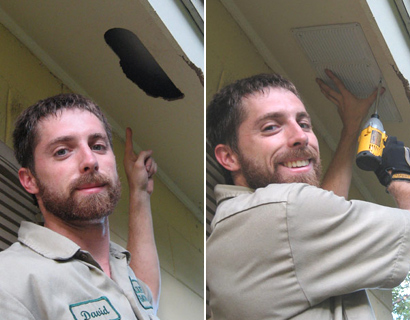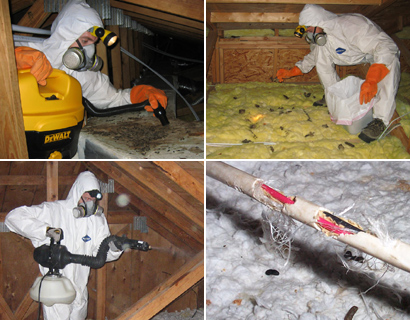- How We Solve Ohio Wildlife Problems
How We Solve Dayton Wildlife Problems
INSPECTION: Once on site, we will perform a full inspection of your home and property. This allows us to use the correct strategy and traps. If the animals are in an attic, a full building inspection is crucial, including the following:
- All ground-level areas, such as piper or A/C line entry & exit areas, A/C chase bottoms, ground-level vents, etc.
- All mid-level areas, such as dryer vents, siding gaps, first floor eaves or dormers, etc.
- We inspect the entire roof, including all plumbing stacks, ridge caps, vents, and other potential gaps or holes.
- We also inspect inside your attic, to identify animals and damage they have caused.
- If the animals are outside, we notice many subtle clues that will assist us in a successful strategy.
TRAPPING, EXCLUSION, REMOVAL: Once we understand what animal species we are dealing with, and the problem, we use the most effective means of removing the animals. We use dozens of different types of traps.
- Trapping - If trapping the animal(s) in live cage traps, trap type, set, and location are crucial to success.
- Exclusion - Oftentimes, we are able to simply set one-way doors or other exclusion devices that allow the animals inside a building to safely exit, but never get back inside.
- Removal By Hand - Sometimes we actually remove animals by hand, or with special tools like snare poles.
- The Law - In all cases, we obey state and local laws regarding wildlife, but aim to take the most humane approach.
ENTRY HOLE REPAIRS: Repairs are a crucial step in the wildlife removal process. In many cases, such as bat or rodent control, the job cannot be performed without detailed repairs, and in all cases, sealing the entry holes shut ensures that no future wildlife will ever enter your home.
- 100% of the entry holes must be found, and sealed shut, or the job is not complete.
- Our repairs are professional contractor grade, look good, and when applicable we use steel, which rodents such as rats or squirrels are unable to chew through.
- We give a written guarantee on our repairs against any future animal entry.
ATTIC DECONTAMINATION SERVICES: It may be desirable to clean your attic after we've removed the animals. They can leave behind large amounts of droppings, urine, hair, oils, food, nesting material, and so on. These remnants can attract insects like cockroaches, and the scent left behind can encourage new animals to chew their way into your house. You might experience odor problems from the waste. It's possible that mold will grow on waste areas.
- We remove or vacuum all droppings, or remove all the soiled insulation.
- We fog the attic with a special enzyme-based cleaner that destroys any organic matter and deodorizes the space.
- We repair damage, such as ductwork, electrical wires, pipes, insulation, and more.
Have you found yourself looking up at your ceiling wondering what that noise is coming from your attic recently? If you have, pick up your phone and call us right now! Your home could be at risk to the damages caused by Ohio's wildlife creatures such as birds, bats, and racoons. We put the time and effort into trapping, removing, and preventing future wildlife from making it's new shelter in your beautiful home, so that you don't have to do it yourself! We service the following cities: Brookville, Carlisle, Centerville, Clayton, Dayton, Drexel, Englewood, Fort McKinley, Germantown, Huber Heights, Kettering, Miamisburg, Moraine, New Lebanon, Northridge, Oakwood, Riverside, Shiloh, Springboro, Trotwood, Union, Vandalia, West Carrollton, Woodbourne-Hyde Park, Bowersville, Casstown, Clifton, College Corner, Eldorado, Farmersville, Fletcher, Gratis, Laura, Ludlow Falls, Phillipsburg, Potsdam, Spring Valley, Verona, West Elkton, West Manchester, BeaverCreek, Fairborn, Huber Heights, and Kettering. We also service the following counties: Greene, Miami, and Preble. If you do not see your city or county listed give us a call!
Other Dayton animal pest control topics:
Skunks Digging in Your Yard
Dangers of Bat Feces
What to do with an Opossum
How to Check for Rat Entry
To learn more about our services, visit the Dayton wildlife control home page.
This month's wildlife how-to article: ABOUT OPOSSUMS: APPEARANCE, BIOLOGY, LIFE CYCLE, HABITAT, DIET, BEHAVIOR
ABOUT OPOSSUMS: APPEARANCE, BIOLOGY, LIFE CYCLE, HABITAT, DIET, BEHAVIOR
Opossums also known as Didelphimorphia, is considered as the largest member of the Marsupials in the world. They are scavengers who get attracted to cans; they can visit human homes and decent on their dumpsters and garbage cans. With over 103 species available across the world, the animal has the capabilities to adapt to adverse weather condition - and that is what makes them successful in places where they exist.
Appearance
The Opossums are mammals with a small-sized body with length measuring up to 76cm. they weigh from 8.8 through 13.2 lb and have a cat-like-mouse looks. They have long snouts, small incisors teeth, large canine, large molar, narrow braincase, as well as facial shape which resemble that of a dog. Opossums have flat feet with opposable digit claw; the skin fur is mainly of awn hair and those with pouch are known to be female species. The animal is such an amazing creature in which many people will like to give it a different description and explanation.
Biology
Opossums are mammals, belonging to the family of Didelphidae; they have amazing history of reproductive pattern of which the female species give birth to young babies that normally look helplessly and tiny as honeybees, but they become lovely as they develop to maturity stage. The mating season begins from February to June every years and sexual maturity can start from 1 year and above. The female species have two years of reproductive age and they can reproduce more than once in a year. It’s amazing to watch the young babies grow, as they sometimes ride on the mother’s back when they hunt for what they will eat. The female species may give birth to as many as twenty young babies in a year, but unfortunately only a quarter of them may likely survive.
Life cycle
The expected lifespan of this animal is 1 to 3 years in the wild, and one to eight years in captivity.
Habitat
Opossums are known as scavengers, so they often disturb human homes in places where they are found. They can also be spotted near the roadside and forests where they search for their prey.
They are attracted to containers and cans and will try to do everything to raid garbage in people’s homes or shops.
Diet
Opossums are good at eating grasses, fruits, as well as nuts. They are known to be predators of mice, birds, snakes, and insects.
They also eat chickens and will not hesitate to decent on worms whenever they see them.
Behavior
The lifestyle of this animal is an interesting experience everyone should witness; they live as nomad by staying in an area where there are availability of food and water. They don’t dig but they sometimes live in ready-made burrows where they live temporarily. When they are threatened, they make a mimicked appearance pretending to be dead or exhibit a fake smell. They are calm, but when they are threatened beyond limit they can react fiercely and growl deeply in form of defense. They are wonderful animals to keep in captivity, even though many see them as pests.





